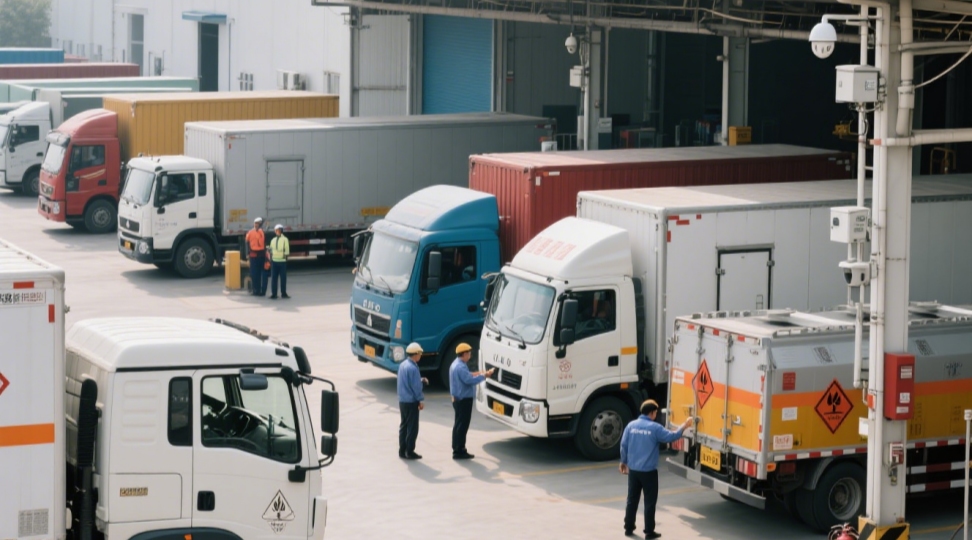Navegación en el transporte de mercancías peligrosas: Guía para las clases 9
Las mercancías peligrosas son sustancias o artículos que representan riesgos para la salud, la seguridad, la propiedad o el medio ambiente durante su transporte. Estandarizadas globalmente por el sistema de las Naciones Unidas, se clasifican en nueve clases según sus principales peligros. Con más de 11 millones de envíos anuales, comprender estas categorías y los protocolos de cumplimiento es crucial para el envío seguro de mercancías peligrosas.
Las 9 clases de mercancías peligrosas: lo que necesita saber
Clase 1: Explosivos
Sustancias que reaccionan violentamente (p. ej., dinamita). Requieren embalaje antichoque y aislamiento de fuentes de calor.
Clase 2: Gases
Gases comprimidos (p. ej., propano, aerosoles). Los cilindros deben estar en posición vertical y protegidos con válvulas.
Clase 3: Líquidos inflamables
Líquidos con puntos de inflamación ≤61 °C (p. ej., gasolina, acetona). Requieren recipientes herméticos.
Clase 4: Sólidos inflamables
Incluye materiales espontáneamente combustibles (p. ej., fósforo) o reactivos con el agua (p. ej., sodio). Requiere espacios secos y ventilados.
Clase 5: Oxidantes y peróxidos orgánicos
Agentes oxidantes (p. ej., peróxido de hidrógeno) que intensifican los incendios. Aislar de los materiales combustibles.
Clase 6: Sustancias tóxicas e infecciosas
Venenos (p. ej., pesticidas) y riesgos biológicos (p. ej., residuos médicos). Exigir el uso de envases sellados y herméticos.
Clase 7: Material radiactivo
Artículos que emiten radiación ionizante (p. ej., uranio). Se aplican contenedores blindados y límites de cantidad estrictos.
Clase 8: Corrosivos
Ácidos/bases que causan daños en tejidos o metales (p. ej., ácido sulfúrico). Los envases de vidrio y plástico requieren amortiguación de impactos.
Clase 9: Mercancías peligrosas diversas
Los materiales peligrosos no están contemplados anteriormente. Incluye baterías de litio, hielo seco, amianto y sustancias peligrosas para el medio ambiente.
Tabla: Guía de referencia rápida para clases de mercancías peligrosas
| Clase | Tipo de peligro | Ejemplos comunes | Regla de transporte de claves |
|---|
| 1 | Explosión | Dinamita, fuegos artificiales | Sin transporte aéreo |
| 2 | Fuga de gas | Propano, aerosoles | Almacenamiento de cilindros en posición vertical |
| 3 | Incendio/explosión | Gasolina, acetona | Contenedores a prueba de vapor |
| 4 | Combustión espontánea | Sodio, fósforo | Ambiente seco |
| 9 | Múltiples subriesgos | Baterías de litio, hielo seco | Estado de carga ≤30 % para el aire (IATA 66.º DGR) |
Modos de transporte y marcos de cumplimiento
Transporte aéreo
Regido por el Reglamento sobre mercancías peligrosas de la IATA (DGR 66.º, vigente a partir de enero de 2025).
Actualizaciones clave: Baterías de litio >100 Wh limitadas al 30 % de carga; nuevos resúmenes de pruebas digitales.
Prohíbe los explosivos (Clase 1) y los materiales radiactivos (Clase 7) en los vuelos de pasajeros.
Transporte marítimo
Sigue el Código Marítimo Internacional de Mercancías Peligrosas (IMDG).
Requiere Declaración DG, marcado de contenedores y segregación por tipo de peligro.
Puertos como Tallin prohíben por completo los envíos de clase 1.
Transporte por carretera y ferrocarril
Utiliza ADR (Europa) o marcos nacionales (por ejemplo, FMCSA en EE. UU.).
Se centra en la estabilidad de la carga, la capacitación de conductores y los kits de emergencia.

Mercancías peligrosas de clase 9: el desafío de los "misceláneos"
Las mercancías peligrosas diversas de la clase 9, a menudo malinterpretadas, incluyen:
Baterías de iones de litio/sodio (UN 3480/3090)
Hielo seco (ONU 1845)
Organismos genéticamente modificados (ONU 3245)
Sustancias peligrosas para el medio ambiente (por ejemplo, contaminantes marinos, ONU 3077).
Crítico para las baterías de litio:
El transporte aéreo requiere clasificaciones de vatios-hora (Wh):
Las baterías húmedas no derramables (por ejemplo, de plomo-ácido) deben tener un voltaje ≤12 V y ≤100 Wh.
Preparación de la documentación: claves para un despacho aduanero sin problemas
El envío de mercancías peligrosas requiere una documentación precisa:
Fichas de datos de seguridad (FDS): deben cumplir con la IATA DGR 66.ª edición (2025) para aire o con la IMDG para mar.
Documentos de transporte:
Certificados de embalaje: Contenedores aprobados por la ONU con informes de pruebas.
Consejo: utilice plataformas automatizadas como Centro de documentos de DR Trans para generar etiquetas y formularios compatibles.
Importación de mercancías peligrosas: lista de verificación previa al envío
Antes de transportar mercancías peligrosas a nivel internacional:
Verificar la clasificación: Confirmar mediante SDS o pruebas de laboratorio (por ejemplo, punto de inflamación para líquidos, LC50 para tóxicos).
Comprobar prohibiciones: algunos puertos restringen clases específicas (por ejemplo, explosivos en Tallin).
Plan de Emergencias: Equipar las unidades de transporte con kits para derrames y EPP.
Socios de auditoría: garantizar que los transportistas tengan certificación de capacitación sobre mercancías peligrosas.
Envíos desde China: Soluciones a medida de DR Trans
El transporte de mercancías peligrosas desde China implica:
Selección del método:
Marítimo: Rentable para mercancías peligrosas de clase 9 de gran tamaño (p. ej., baterías). Tránsito: 25–40 días.
Aire: Envíos urgentes (3–10 días); sigue IATA DGR 66.
Pasos críticos:
Embalaje: Cajas certificadas por la ONU con etiquetas de peligro (por ejemplo, diamante "Varios" para la clase 9).
Aislamiento: Separe las baterías de los materiales combustibles.
Declaraciones: Anotaciones de B/L y prealertas aduaneras.

Cómo DR Trans garantiza el cumplimiento:
Experiencia integral en clase 9: desde la preparación de SDS hasta el embalaje IMDG/ADR.
Relaciones portuarias: Atraque prioritario para carga distribuida en Shanghai/Ningbo.
Seguimiento en tiempo real: monitoreo de temperatura y presión para artículos sensibles.
Reflexiones finales
Dominar las clases de mercancías peligrosas y las normas de transporte previene retrasos, multas e incidentes. Con la evolución de las normativas, como la 66.ª edición de la DGR de la IATA y las actualizaciones del Código Marítimo Internacional de Mercancías Peligrosas, la colaboración con especialistas es fundamental.
Ya sea que esté trasladando baterías de litio (mercancías peligrosas diversas de clase 9) o productos corrosivos, el equipo de DR Trans agiliza su cadena de suministro. Explore nuestras soluciones para mercancías peligrosas—donde el cumplimiento se une a la confiabilidad.
¿Tiene envíos de mercancías peligrosas complejos? El 87 % de la carga retrasada no cuenta con la ficha de datos de seguridad (FDS) ni el etiquetado adecuados. Audite su proceso hoy mismo.
















 IPv6 RED SOPORTADA
IPv6 RED SOPORTADA
